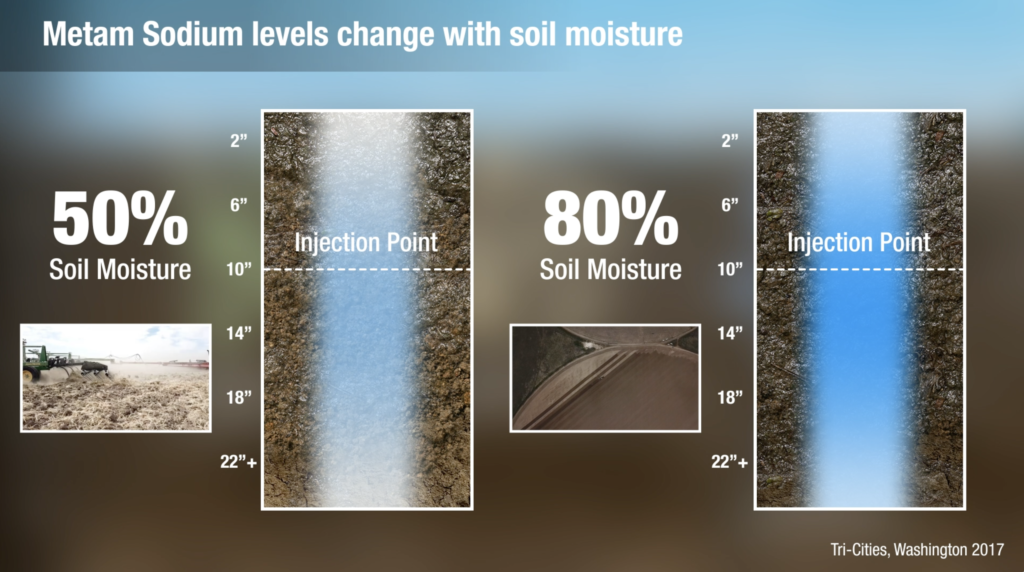Study shows placement of fumigant metam sodium key to effectiveness
Decades of proven results show that the widely used soil fumigant metam sodium is a reliable tool for suppressing weeds, diseases and nematodes.
But recent field studies reveal new findings about the importance of soil preparation, soil moisture and precision placement that are helping applicators gain a greater understanding of how to enhance metam sodium performance.
Results from more than 25,000 post-application soil readings, conducted by NovaSource and several cooperators, show that applicators can better match metam sodium to the targeted pest.
Post-application measurements of metam sodium presence in soil were taken at more than 100 locations in Washington, Idaho, Oregon, Nebraska, Texas, Michigan, South Carolina and Georgia over a two-year span. This variety of soil types and growing conditions enabled study participants to gain a greater understanding of both the product and the properties of the soil where it is being applied.
For many years, a common assumption has been that all fumigants behave generally the same way upon application. Many applicators have thought that metam sodium acted as a typical fumigant by moving widely, deeply and evenly throughout the soil profile. But it’s not true. The insight revealed in the NovaSource findings is that precision placement is key because metam sodium lacks mobility in the soil because of its low vapor pressure.
“Metam sodium is an older product and it seems like we should know a lot about it,” said Travis Meacham, a potato grower for Friehe Farms in Moses Lake, Washington. “There are some real interesting things that we’re finding out lately that are kind of debunking some assumptions we thought before about the movement, what moisture does with the movement and how important placement is in the ground.”
Placement

For years, growers have simply chemigated or shanked metam sodium — thinking the product would move throughout the entire soil profile. However, field studies show that vertical and lateral movement are not happening in the ways that many growers have often assumed. In fact, when chemigated, metam sodium is found primarily in the top 4 to 6 inches of soil.
To do its job, metam sodium needs to come in contact with the pest it’s suppressing.
“Different pests are found at different depths. That’s why it’s important to understand — and implement — application techniques that enhance the proximity of the product to the pest,” said Kyle Coleman of NovaSource, who spearheaded the study.
Irrigation level
Another insight from the data reveals the importance of moisture, because metam sodium was observed to move farther in soil that was already pre-irrigated. To make sure that metam sodium moves and to get it closer to the pest, it is most effective to properly prepare the soil in advance of application.
“Ideally, you want to achieve up to 80% soil moisture throughout the targeted soil profile, and maintain that moisture level for up to 30 days in advance of the day you apply the product, if possible,” Coleman said.

According to Coleman, average readings of test results at 80% moisture were higher and lasted longer than in 50% soil moisture.
This level of soil preparation also has other benefits.
Moisture in the soil activates respiration, and respiring pests are easier to control, as stated by Steven Fennimore, an Extension Weed Scientist at the University of California Davis. “Actively respiring seeds, weeds and diseases are more susceptible to fumigants. Dry seeds are hard to kill,” Fennimore said.
Good soil tilth also plays an important role in metam sodium movement. Data in the Studies revealed that dry, cloddy, and compacted soil will not produce the same results as those obtained from a well-prepared soil.
“Regardless of the depth of shank application, mobility is always better in non-compacted soil with proper moisture content,” Coleman said.
Another critical factor in maximizing the effectiveness of metam sodium is the application technique you choose for correct placement near the weed seed, disease or nematode.
Movement
For example, field studies show that shank-injected metam sodium generally moves up to 6 inches above and as many as 6 inches below the injection point in moist, ripped soil.
“Those are maximum levels,” said Coleman. “Soil type, a hard pan, or dry soil near the surface quickly reduces those numbers.”
In some cases, additional vertical coverage is desired to reach targeted pests and growers have utilized two levels of injection. Coleman advises that in those cases, applicators factor in pest location and the gallons per vertical inch being applied.
“People going after shallow pests and deep nematodes run the risk of being ineffective at both,” he said. “As you stretch an application vertically you need to ensure that an effective dose is being applied throughout that targeted region.”
Study results show that no matter where you’re using metam sodium, certain procedures and principles for maximizing its effectiveness always apply.
When you know your target pest and its depth in the soil, three things drive the most effective use of metam sodium:
- Prepare the soil the same way you’d create ideal growing conditions, by making sure it’s mixed, mellow and non-compacted.
- Moisten the soil for up to 30 days. Remember, you’re both conditioning the soil and enabling the pest to respire.
- Place the product exactly where you need it to work by using the most effective application technique.
“Armed with this information, you’ll know exactly where to place your metam sodium to be most effective,” Coleman said. “And always be a good steward of this product. Use it according to labeled directions, following all labeled requirements and restrictions.”








